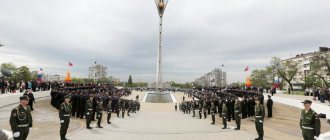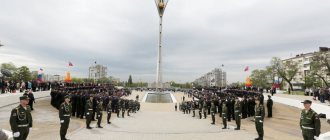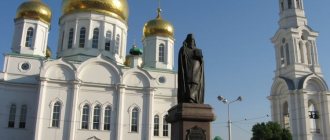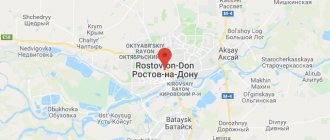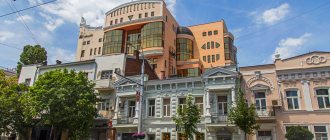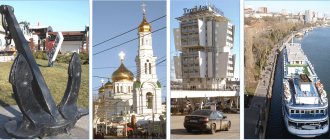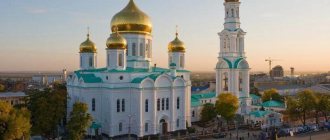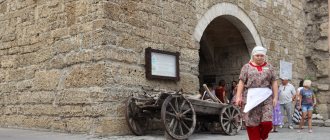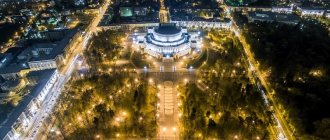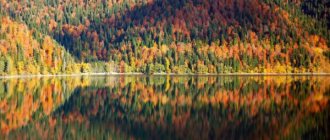Rostov-on-Don is the administrative center of the Rostov region, located near the confluence of the Don into the Sea of Azov, on its right bank. In 1749, Empress Elizaveta Petrovna issued a decree on the establishment of Temernitsk customs at the Bogatoy Spring on the right bank of the Don; the date of the decree is considered the day the city was founded. Rostov-on-Don is often unofficially called the southern capital of Russia and the Gates of the Caucasus.
Construction of the Rostov fortress began only in 1761, and it received city status in 1797. In 1806, the city received its current name - Rostov-on-Don - and by the end of the 19th century. became one of the richest and most beautiful cities in Russia. During the revolution and World War II, Rostov-on-Don suffered greatly, but in 1981 its large-scale reconstruction and development began.
River Station
The river station complex in Rostov-on-Don, which includes, in addition to the two-story station building, the 9-story Anchor Hotel, was put into operation in 1977. It is located on the right bank of the Don River, between the Voroshilovsky and Temernitsky bridges, at the address: Beregovaya Street, building 10. Now this building houses a shipping company.
Photo: © Anatoly Belov │ SNEG5.com
River station in Rostov-on-Don. June 2022 Photo: © Anatoly Belov │ SNEG5.com
River station in Rostov-on-Don. June 2022 Photo: © Anatoly Belov │ SNEG5.com
LO LoveOpium
The largest city in southern Russia is located on the banks of the Don River, 50 km from the Sea of Azov. Now 1.13 million people live in Rostov-on-Don - the city ranks 10th in terms of population in the country.
49 photos
Photos and text by Slava Stepanov
1.
Officially, the founding date of the city is December 15, 1749, when Empress Elizaveta Petrovna founded the Temernitsa customs house by decree. Since the 19th century, Rostov-on-Don began to be called the “Gateway of the North Caucasus”, since the only route to the southern borders of the country passed through Rostov.
2.
In 2022, Rostov-on-Don hosted matches of the FIFA World Cup. Five games took place in the Rostov Arena, built for the championship. At two of them, all the stands were completely filled - more than 43 thousand spectators watched the matches.
3.
The territory of Rostov is divided into 8 administrative districts. Four of them - Zheleznodorozhny, Kirovsky, Leninsky and Proletarsky - partially lie on the left bank of the Don. All the rest - Sovetsky, Oktyabrsky, Voroshilovsky and Proletarsky - are only on the right bank.
4.
Bolshaya Sadovaya is the central street of Rostov-on-Don. Many buildings on it were built in the pre-revolutionary period.
5.
A residential building in the Stalinist Empire style and the Rostov Central Department Store form a kind of gateway to Bolshaya Sadovaya at the corner with Budennovsky Prospekt.
6.
Rostov-on-Don remained a small but strategically important city until the beginning of the 20th century. Thanks to industrialization, its population began to grow rapidly. The city became a millionaire in 1987.
7.
Soborny Lane adjoins Bolshaya Sadovaya. During preparations for the World Cup, the lane became pedestrian.
8.
The Cathedral of the Nativity of the Blessed Virgin Mary is the cathedral of the Rostov and Novocherkassk diocese. The building was built in 1854–1860. designed by architect Konstantin Ton. Thon's most famous work is the Moscow Cathedral of Christ the Savior.
9.
The new Voroshilovsky Bridge connects the banks of the Don; along it you can get from Rostov-on-Don to Azov and Bataysk. The six-lane bridge was built on the site of an old two-lane bridge. On the right bank near the bridge there is a beautiful Don embankment almost 2 km long.
10.
The 16-storey business building was built on Serafimovicha Street two blocks from Bolshaya Sadovaya in 2006.
11.
The length of Bolshaya Sadovaya is almost 4 km. The street runs through the Kirovsky and Leninsky districts of Rostov-on-Don.
12.
The administration and Duma of Rostov-on-Don work in a pre-revolutionary building built in 1899 for the City Duma.
13.
The building is decorated with high domes and rich stucco in the Baroque style.
14.
The height of the memorial on Theater Square is 72 meters.
15.
The stela “To the Liberators of Rostov” was opened in 1983 on the 40th anniversary of the liberation of Rostov-on-Don.
16.
Rostov Academic Drama Theater named after. Maxim Gorky on Teatralnaya Square is often called a tractor for its unusual shape. The current building was restored after the Great Patriotic War, but still repeats the idea of the architects who tried to repeat the outlines of the first Soviet tractor “Kommunar”.
17.
The stele “Liberators of Rostov” is decorated with a sculpture of the winged goddess of victory Nike. It is made of copper and covered with gold leaf.
18.
The building of the North Caucasus Railway Administration was built in 1911-1913 in the Art Nouveau style. The huge building has three courtyards.
19.
Rostov-on-Don is a very green city. In 2012, it took 1st place in the ranking of the quality of the urban environment.
20.
The Church of the Intercession of the Blessed Virgin Mary was one of the oldest in the city, but was destroyed in 1930. It was restored and opened in a new form in 2007. In Pokrovsky Park near the temple there is a monument to Elizaveta Petrovna, who founded Rostov-on-Don.
21.
The Square of Soviets appeared in Rostov-on-Don in the middle of the 19th century. At that time it was called New Bazaar Square, and the buildings in this area were predominantly one-story. A century later, this place became the administrative center of the city.
22.
The government of the Rostov region is located in the House of Soviets. The building began to be built before the Great Patriotic War, and after its end it was restored until 1968.
23.
The former State Bank Office is a monument in the neoclassical style, built in 1913–1915. Now there is a branch of the Central Bank here.
24.
Rostov is located on the Don, through which it is connected with the Azov and Black Seas. And thanks to the system of river canals, the city has access to the Caspian, Baltic and White Seas.
25.
The Rostov railway drawbridge consists of three spans, the middle of which is raised to allow ships to pass through.
26.
The Don has always been an important transport artery for the city. Therefore, bridges were built in such a way that they could pass ships. For example, on the first bridge, built in 1874, one of the trusses could be rotated to allow ships to pass through.
27.
The station square of Rostov-on-Don is adjacent to the Temernik River, at the mouth of which the city was founded.
28.
The Rostov-Glavny railway station with a 14-story hotel stands on the site of the old station, opened back in the 1860s.
29.
The railway station of Rostov-Glavny station includes 6 platforms: 3 main and 3 suburban. The station primarily serves passenger transportation.
30.
There is also a bus station on Station Square in Rostov-on-Don. From it you can travel to Crimea, Krasnodar and Stavropol territories, Ukraine, the republics of the North Caucasus, etc.
31.
There is a seahorse on the spire of the Gench-Ogluev apartment building next to the administration of Rostov-on-Don.
32.
Rostov-on-Don is a colorful city. The facades of many houses are decorated in bright colors and include many decorative elements. The photo shows a house on Bolshaya Sadovaya, 48.
33.
The intersection of Bolshaya Sadovaya and Budennovsky Prospekt. Behind the building with the turret on the left is the park named after. M. Gorky.
34.
The House of the Martyn Brothers, or simply the Red House, was built at the end of the 19th century by order of the British citizen Ivan Martyn. Before the revolution, the two-story brick building even housed the US Consulate. After that there are communal apartments and the House of Artists. Nowadays the State Museum-Reserve of M.A. operates here. Sholokhov.
35.
Rostov State Economic University (RGEU) is located on the corner of Bolshaya Sadovaya and Voroshilovsky Prospekt. This is the largest economic university in the city.
36.
Tokarev's apartment building is now occupied by a clinic. The facade of the pre-revolutionary building is decorated with stucco, and on the third floor there is a sculpture of Hygeia, the daughter of the ancient physician Asclepius.
37.
38.
The apartment building at 46 Budyonnovsky Prospekt was built at the beginning of the 20th century by order of the owner of a confectionery factory and member of the city government, Vladimir Kirillovich Chirikov. Now this is the Leninsky district police department.
39.
The clock tower on the roof of the Central Department Store has four dials.
40.
The left bank part of Rostov-on-Don is popularly called Levberdon.
41.
The building of the North Caucasus Railway Administration was built in 1911-1913 in the Art Nouveau style. The huge building has three courtyards.
42.
43.
In the center of the unique Pervomaiskaya Square in the New Settlement microdistrict there are two kindergartens, a school, a stadium and a psychoneurological clinic. The streets of the New Settlement ring around Pervomaiskaya Square.
44.
The main building of the Southern Federal University was built in 1917, originally as an apartment building.
45.
Now it is a monument of federal significance.
46.
The height of the One Sky Ferris wheel in the park named after. October Revolution - 65 meters.
47.
Rostov-on-Don is located just 50 km from the Sea of Azov. The city port accepts river-sea class vessels.
48.
Green Island belongs to Rostov-on-Don. You can get to it via a pontoon bridge from the right bank of the Don. There is also a railway bridge across the bridge - this is a line to Bataysk.
49.
Also see:
- Tomsk from above - the Siberian city of students
Tags: , height, cities, Russia
Monument to M. A. Sholokhov
Monument to M. A. Sholokhov on the embankment in Rostov-on-Don. Sculptor: N.V. Mozhaev. Opened on May 24, 2000. Installed on a marble pedestal, there is a recognizable Sholokhov flourish and a well-known almost life-size figure in a simple blouse with the same cigarette in his hand. The monument is cast from copper. Height – just over two meters. June 2022 Photo: © Anatoly Belov │ SNEG5.com
Monument to M. A. Sholokhov. June 2022 Photo: © Anatoly Belov │ SNEG5.com
Monument to M. A. Sholokhov. June 2022 Photo: © Anatoly Belov │ SNEG5.com
Monument to M. A. Sholokhov on the embankment in Rostov-on-Don. June 2021 Photo: © Nikita Kirichenko │ SNEG5.com
Monument to M. A. Sholokhov. Photo: © Nikita Kirichenko │ SNEG5.com
Best hotels of Rostov-on-Don
Related materials:
- 29 best attractions in Orel,…
- 24 must-see attractions in Cappadocia
- 32 best attractions in Vyborg
- 43 best attractions in Minsk,…
- 38 sights of Pskov recommended for…
- 37 Best Berlin Attractions
- 38 best attractions in Barcelona
- 33 attractions of Bakhchisaray that are worth visiting
- 25 sights of Olenevka that are worth seeing
Did you like the article? Share with friends:
Sculpture "Rostovite"
Sculpture "Rostovchanka" on the embankment in Rostov-on-Don. Sculptor A. A. Sknarin. Installed in 1984. The sculptor presented the image of a beautiful and young resident of the city, facing the sources of the Don. June 2022 Photo: © Anatoly Belov │ SNEG5.com
Sculpture "Rostovite". June 2022 Photo: © Nikita Kirichenko │ SNEG5.com
Sculpture "Rostovite". June 2022 Photo: © Nikita Kirichenko │ SNEG5.com
Sculpture "Rostovchanka" on the embankment in Rostov-on-Don. June 2021 Photo: © Anatoly Belov │ SNEG5.com
Population
More than a million people live in Rostov in 2022. However, there is also a high mortality rate: every year more people die than are born. The birth rate is connected, first of all, with the fact that young people getting married do not strive to quickly have children, since existing material opportunities do not always allow this.
You can find out about the average life expectancy in Russia by following this link.
In a metropolis, where family ties do not play a significant role, the importance of assistance from the state to newlyweds is important, who, under various federal programs, can improve their living conditions, and promising work opens up new horizons for them in life.
Building of Rostov Technical University
There are many schools (300 general education) and universities in the city, but the main recent trend is to transfer education in the most prestigious areas to a paid basis.
Sculptures “Anchor” and “Artist”
The sculpture “Anchor” on the embankment in Rostov-on-Don. June 2022 Photo: © Anatoly Belov │ SNEG5.com
The sculptural composition “Artist” on the embankment in Rostov-on-Don. Installed in 2013. Sculptor: Oleg Kukushkin. June 2022 Photo: © Anatoly Belov │ SNEG5.com
Sculpture "Cranes"
Photo: © Anatoly Belov │ SNEG5.com
Sculpture "Cranes" on the embankment in Rostov-on-Don. June 2021 Photo: © Anatoly Belov │ SNEG5.com
Sculpture "Cranes" on the embankment in Rostov-on-Don. June 2021 Photo: © Nikita Kirichenko │ SNEG5.com
Sculpture "Cranes". Photo: © Nikita Kirichenko │ SNEG5.com
Sculpture “Mechanical Heart”
Symbolizes the key role of the Don region in the new industrialization of southern Russia. Development of the investment development agency of the Rostov Region for the International Investment Forum “Sochi-2012”.
Of no less interest is the paving stones on which this unusual structure is installed. She is not simple here. A During the Great Patriotic War: It was founded during the end of the Second World War after work was carried out to restore the embankment. Nazi prisoners of war took part in laying the paving stones.
Sculpture “Mechanical Heart”. Embankment in Rostov-on-Don. June 2022 Photo: © Anatoly Belov │ SNEG5.com
Sculpture “Mechanical Heart” (“Industrial Heart”). Embankment in Rostov-on-Don. June 2022 Photo: © Anatoly Belov │ SNEG5.com
Sculpture “Mechanical Heart”. June 2022 Photo: © Nikita Kirichenko │ SNEG5.com
Photo: © Nikita Kirichenko │ SNEG5.com
Photo: © Nikita Kirichenko │ SNEG5.com
Sculpture “Mechanical Heart” (“Industrial Heart”). Embankment in Rostov-on-Don. June 2022 Photo: © Anatoly Belov │ SNEG5.com
Climate and ecology
The weather in Rostov is due to the fact that the city is located in the steppe zone. It is quite hot here in the summer, and there are strong winds all year round, i.e. the climate in the city is moderate continental.
A more clear and visual idea of what weather indicators prevail in Rostov during the year is given by the following table.
| month | Average t (minimum and maximum) | Amount of precipitation (mm per month norm and maximum) | Snow thickness (in cm, average and maximum) | Wind (m/s average per month) | Air humidity in % | Number of clear, cloudy and cloudy days |
| January | -5,4 (-32) | 57 (130) | 5 (55) | 3,6 | 84 | 2/10/19 |
| February | -5,7 (-31) | 51 (168) | 7 (55) | 3,7 | 81 | 2/11/15 |
| March | -1 (-28) | 52 (111) | 4 (69) | 3.9 | 76 | 3/14/14 |
| April | +6 (-10) | 44 (125) | 3,4 | 66 | 3/16/11 | |
| May | +11,5 (+35) | 52 (180) | 2,9 | 63 | 5/19/7 | |
| June | +15,8 (+38) | 65 (147) | 2,5 | 64 | 4/21/5 | |
| July | + 18 (+39) | 50 (128) | 2,6 | 61 | 8/20/2 | |
| August | +17 (+40) | 44 (125) | 2,7 | 59 | 10/19/13 | |
| September | +12 (+38) | 43 (169) | 2,9 | 67 | 7/19/4 | |
| October | +6 (+31) | 39 (196) | 3,1 | 75 | 5/17/9 | |
| november | 0 (-25) | 50 (122) | 3,4 | 84 | 2/11/17 | |
| December | -4 (-32) | 67 (150) | 2 (30) | 3,6 | 86 | 2/9/20 |
This table allows you to see a clear picture of the climate, namely: short, warm winters, hot summers with many clear days, dry air and little rainfall in winter. There may not be any snow at all all winter.
As for the ecology of the city, like any large city in Rostov, the main problems are related to pollution:
- air, due to the release of harmful substances by industrial enterprises, but mainly by road transport (it accounts for 90% of all emissions into the atmosphere);
- water pollution due to the fact that housing and communal services are worn out by 60%, wastewater is insufficiently treated, in general, clean water is one of the main problems for Rostov.
The treatment facilities were built in 1929 and 1934; they have become significantly dilapidated and require reconstruction. At the same time, green spaces occupy 34% of the city’s territory, which is not enough by modern standards.
You can read about the dirtiest cities in Russia in terms of ecology by following this link.
Sculptural composition “Gregory and Aksinya”
The sculptural composition “Gregory and Aksinya” on the embankment in Rostov-on-Don. June 2022 Photo: © Anatoly Belov │ SNEG5.com
Pervomaisky district
It is located in the northeast of Rostov-on-Don, the area of the district is 44 km². It has the largest population, over 186,000 people.
The area is industrial - the Rostselmash plant was originally built, and next to it there is a settlement for workers, designed for approximately 30,000 people. Over time, more villages and new enterprises were built.
But the ecology here is quite good. The district is green, almost 1/3 of its territory is occupied by trees, parks, and public gardens.
There are many reservoirs located here:
- Northern Reservoir;
- Rostov Sea;
- Mozhaisk ponds.
One of the largest bodies of water in Rostov-on-Don is the Rostov Sea.
All of them have well-maintained beaches and embankments.
Several stadiums have been built in the area, including Olimp-2, where the Rostov football team hosted such famous rivals as Ajax, Manchester United and Bayern.
The area is actively developing. New neighborhoods are being built literally on every corner; the land of the city’s old airport was even given over for them. Mostly modern multi-storey buildings are being built, but prices for apartments are low, since the area is considered a dormitory-industrial area.
There are about 50 educational institutions here for city residents, including 2 universities, a dozen markets, and many shops. There are large shopping centers, for example.
Transport accessibility is good. The Selmash railway station is located on the territory of the district, and it was here that the first trolleybus route was laid. Public transport runs regularly, the roads are wide, and traffic jams are rare.
THIS IS INTERESTING. Previously, the Pervomaisky district was considered the most criminal - the gang of the Tolstopyatov brothers, also known as the Fantomas, operated here. The traces of their bullets were not removed from the walls of the stores even after repairs - they were left as a souvenir of the terrible events.
Sculptural composition “Sport”
Sculptural composition “Sport” on the embankment in Rostov-on-Don. Installed in the 1950s. June 2022 Photo: © Anatoly Belov │ SNEG5.com
Photo: © Nikita Kirichenko │ SNEG5.com
Sculptural composition “Sport” on the embankment in Rostov-on-Don. Installed in the 1950s. June 2022 Photo: © Anatoly Belov │ SNEG5.com
Monument to Admiral F. F. Ushakov
Monument to Admiral F. F. Ushakov. Sculptor A. A. Sknarin. Installed in 2002 on the embankment in Rostov-on-Don. June 2022 Photo: © Anatoly Belov │ SNEG5.com
Monument to Admiral F. F. Ushakov. Sculptor A. A. Sknarin. Installed in 2002 on the embankment in Rostov-on-Don. June 2022 Photo: © Anatoly Belov │ SNEG5.com
Sculptural composition “Cancer”
The sculpture was installed in 2013 as an original decoration of a favorite vacation spot for local residents and guests of the city. This sculptural composition, as a small memorial plaque indicates, is a gift to Rostov-on-Don from Rostov Port LLC.
It is no coincidence that cancer is immortalized in bronze on the embankment. It is these inhabitants of the aquatic environment that are the brand of Rostov-on-Don, in which boiled crayfish is a local “national” dish. It is boiled crayfish that is fed here to visiting stars, politicians, writers and all guests of the city.
Sculptural composition “Cancer” on the embankment in Rostov-on-Don. June 2022 Photo: © Anatoly Belov │ SNEG5.com
Surb-Khach Church-Museum
One of the oldest beautiful buildings in the city is the church of the Armenian monastery Surb-Khach (“Holy Cross”), built in 1786-1792. designed by the Russian architect I.I. Starova. In its building there is a branch of the Rostov Regional Museum of Local History - the Museum of Russian-Armenian Friendship - a place for carefully preserving the history and culture of the Don Armenians.
Next to the building of the temple-museum there is another popular place - a spring with holy and healing water. And near the walls of the Surb-Khach monastery lie many famous people of Armenian nationality - poets, writers, politicians.
Monument to G. Ya. Sedov
Monument to G. Ya. Sedov on the Walk of Fame, founded in 2022 in honor of the 70th anniversary of the formation of the Rostov region. Rostov-on-Don, June 2021 Photo: © Anatoly Belov │ SNEG5.com
View from the observation deck at the monument to G. Ya. Sedov of the Rostov Arena stadium. Rostov-on-Don, June 2022. Photo: © Anatoly Belov │ SNEG5.com
View from the observation deck at the monument to G. Ya. Sedov on the Voroshilovsky Bridge. Rostov-on-Don, June 2022. Photo: © Anatoly Belov │ SNEG5.com
Don is a navigable river
River boats pass under the Voroshilovsky Bridge (height 17 m). Rostov-on-Don, June 2022. Photo: © Anatoly Belov │ SNEG5.com
River Don. Rostov-on-Don, June 2022. Photo: © Anatoly Belov │ SNEG5.com
Floating cafe. Rostov-on-Don, June 2022. Photo: © Anatoly Belov │ SNEG5.com
Photo: © Nikita Kirichenko │ SNEG5.com
They change the light bulbs in the lanterns. Photo: © Nikita Kirichenko │ SNEG5.com
Deserted embankment. Rostov-on-Don, June 2022. Photo: © Anatoly Belov │ SNEG5.com
Photo: © Nikita Kirichenko │ SNEG5.com
Night views of Rostov-on-Don
Suburban railway station of Rostov-on-Don. June 2022 Photo: © Nikita Kirichenko │ SNEG5.com
Main railway station of Rostov-on-Don. June 2022 Photo: © Nikita Kirichenko │ SNEG5.com
